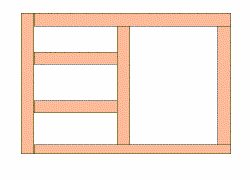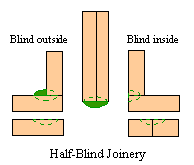 |
Using Biscuits in Framework
Not only are biscuits invaluable for carcase construction, they are also an excellent means to assemble face frames as well, providing one of the highest quality methods of construction ever devised for the woodworker. With some thought as to their final orientation within a framework, almost any configuration is possible using the standard sizes of #0,10, and 20. My favored procedure is to cut the locations required on the frame components, and assemble directly to the carcase. This strategy has the following advantages:
I secure the frame parts to the case using brads and glue. While joining to the case with biscuits is possible, the strength advantages are negated by the extra time it takes to accomplish this, but on heavy-duty applications, the use of biscuits along the bottom rail will provide extra structural capacity and is helpful to it's neighboring frame parts.
My system of carcase construction is to build a basic box and set it upon a separate base or plinth. This greatly simplifies the construction process as most parts are now symmetrical, fabrication, installation and leveling are easier, and small offcuts can be used in fabricating the base. Stock width of 1-1/2" is typical, and is a popular size for most cabinet framework; a study of the Placement Scheme shows some of the variety of biscuit installation options used.

The excess biscuit can be trimmed back flush with its surface, and left as is or simply filled if a particular cosmetic appearance is desired. Note that oftentimes the excess needs no trimming at all, such is the case when used to define a drawer bay. Slide and guide requirements are generally of such clearance needs that a drawer box will never contact this protrusion. In the instance of door bays, I do trim back flush, but go no further. In cases where I feel I want to fill, I do this post-finishing, as it's easier to obtain a better match.
1/2 Blind joinery methods give further options as to employment of biscuits in "sensitive" visual areas. Cutting two components side by side will limit breakout to one side only, and the drawing shows the benefits. Remember, a biscuit does not need to be centered to be useful, offsetting is a very effective technique that will help in many situations.

The 45- degree miter is well suited for assembly with biscuits, and is a great choice for doors constructed in the frame and panel style as well as the outer perimeter of face frames. You can easily calculate how much length you'll have in the frame member that is cut at a 45-degree angle. In the example, 2" (W) X 1.414 = 2.828" (L), almost 2-7/8", enough to comfortably house a #20 biscuit.

I have come to the conclusion that visual evidence of biscuit use is no less desirable than visual evidence of other joinery methods like dovetails, box, or wedged tenon joints. It is an indicator of the quality of construction and is thus a reassuring sign, not a negative one. Properly trimmed and dressed if in a conspicuous location, a spline is indeed a hallmark of craftsmanship. No question then, that biscuit joinery has a serious place in frame construction, and delivers on the promise of strength, speed, ease of use, and adaptability to most all woodworking needs, and in reality no special sizes are needed when strategic placement is used.
 For more information
about biscuit joinery see: http://www.ameritech.net/users/hankm/wme.htm
For more information
about biscuit joinery see: http://www.ameritech.net/users/hankm/wme.htm
Bookmark This Page!
|
So
tell me, |
USE YOUR BROWSER'S BACK BUTTON FOR PREVIOUS SCREENS